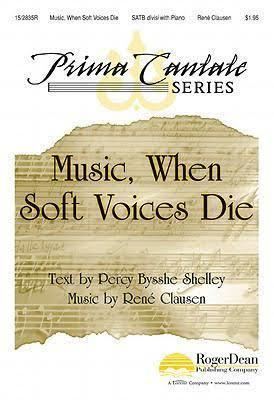6.4 /10 1 Votes
First published in Posthumous Poems Publication date 1824 (1824) | 3.2/5 Poem Hunter Publisher John and Henry L. Hunt Lines 8 | |||||||||||||||||||||||||||||||||
 | ||||||||||||||||||||||||||||||||||
Subject(s) Endurance of the memories of events and of sensations Similar Works by Percy Bysshe Shelley, Other books | ||||||||||||||||||||||||||||||||||
Roger quilter music when soft voices die
"Music, When Soft Voices Die" is a major poem by Percy Bysshe Shelley, written in 1821 and first published in Posthumous Poems of Percy Bysshe Shelley in 1824 in London by John and Henry L. Hunt with a preface by Mary Shelley. The poem is one of the most anthologised, influential, and well-known of Shelley's works.
Contents
- Roger quilter music when soft voices die
- Music when soft voices die ssa victor c johnson
- Text
- Summary
- Musical compositions
- References
Music when soft voices die ssa victor c johnson
Text
Music, When Soft Voices Die
Music, when soft voices die,
Vibrates in the memory;
Odours, when sweet violets sicken,
Live within the sense they quicken.
Rose leaves, when the rose is dead,
Are heap'd for the belovèd's bed;
And so thy thoughts, when thou art gone,
Love itself shall slumber on.
Summary
The poem was published as "To---" in 1824 under Miscellaneous Poems in two stanzas of four couplets each containing four lines in Posthumous Poems.
The theme of the poem is the endurance of the memories of events and of sensations.
Mary Shelley edited the poems and wrote the preface to the collection. She described the poems: "Many of the Miscellaneous Poems, written on the spur of the occasion, and never retouched, I found among his manuscript books, and have carefully copied: I have subjoined, whenever I have been able, the date of their composition."
Musical compositions
Many composers and musicians have set the poem to music with vocal accompaniment. Among the composers are Charles Wood as a three-part song in 1915, Frank Bridge, for mixed chorus a capella, in 1904, Eric Nelson in 1999, Canadian composer Stephen Chatman, as a part of his set "There Is Sweet Music Here," in 1993, Sir Charles Hubert Parry in 1897, Three Songs, Opus 12, Ralph Vaughan Williams in 1893, Sergei Taneyev, Opus 17, No. 3, Pust' otsvuchit, in 1905, Rebecca Clarke for mixed chorus in 1907, Peter Warlock in 1911 (two versions), Liza Lehmann for voice and piano, Henry Cowell in 1922, Jack Gibbons, Opus 17, Samuel Barber, for piano and voice in 1926, Ernest Gold, Quincy Porter in 1947, Roger Quilter, for voice and piano, Opus 25, No. 5, in 1927, John Harbison for SATB choir and organ or harpsichord in 1966, Victor C. Johnson for piano and choir, Stephen Chatman for chorus and oboe in 1984, John H. Ratledge for SATB/a cappella in 1992, Geoffrey Bush for chorus, David Diamond for voice and piano, Gary Bachlund, for baritone and piano in 2009, and Philip Legge for choir and piano in 2010.
